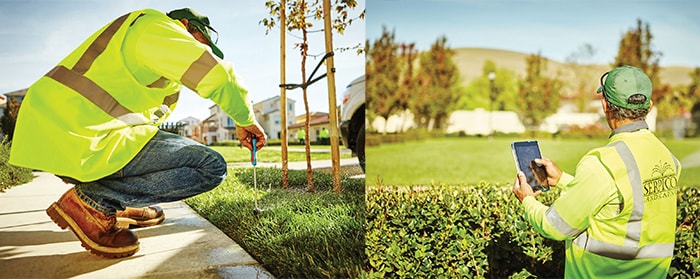Fertilizer isn’t just fertilizer. It’s important to know exactly what’s in the bag for a lot of reasons.

Click Here to View Original Article
Peter Novak has a lot of clients to please. As the vice president of Serpico Landscaping in Hayward, California, a company with $10.7 million in annual sales, the fertilizer products he uses for his lawn care customers (primarily HOAs and commercial business parks) have to not only be effective but save labor and conform to environmental standards.
When analyzing what’s in the bag, Novak says you first need to look at the blend, or amount of nitrogen, phosphorous and potassium. Then, you must look at how those nutrients are going to be delivered — for example, via liquid, granular, synthetic, organic, etc. and how they are going to be released.
For the last four to five years, Turfgro, containing Koch Turf & Ornamental fertilizer and distributed by Horizon, has been answering the call for Serpico.
“We’ve not seen any need to change because it has performed very well,” Novak says. “We’ve been able to turn around some really sick and disorderly lawns with some overseeding here and there, aeration and a feeding and protecting program.”
When Serpico makes its bulk buy of fertilizer, they’re making a considerable purchase, so they want to make sure they’re buying a fertilizer that provides the right blend, delivery and release method in a way that matches their base annual fertilizer program. Then, they tailor that program to the needs of their clients’ lawns based on what a soil analysis indicates to them.
“The program we have is also based off of the idea that we’re going to use slow-release granulars,” says Novak. “That’s primarily how we apply our fertilizer because those will feed and protect over the course of three to six months, depending on which blend, and lowers our overall forecasting cost to do fertilizer applications. That fertilizer costs a little more because it has a better blend, better ingredients and slow release, but it definitely gets us a return on less applications and less labor to apply.”
In the first quarter of the year, Serpico uses a 15-0-5 blend with preemergent built in (Dimension), backed up by aeration in February. In May, they use 24-3-12 to get them through August, and then they do 12-4-16 and wrap up in November with 14-14-14.
Ultimately, Serpico is doing four to five applications a year, depending on what they’re fertilizing. Different blends are used at different times of the year.
“One thing we communicate to clients — because it’s a hot topic in the Bay Area — is that our philosophy is to fertilize as little as possible\ but still get them a beautiful lawn,” says Novak. “In order to do that, we utilize slow-release fertilizer with different components in them for protection, such as preemergents. With those built in, we can get three to six months of protection and feeding, depending on the blend, and that means we’re not throwing down fertilizer every month. When it breaks down and goes into the soil, we’re not constantly reloading.”
There’s a fine line to walk with customer education, Novak says. It depends on the temperament of society the LCO is operating in. Obviously, in the Bay Area, there may be a different attitude toward the contents of fertilizer.
“It’s up to the contractor to know their audience, and then tailor their communication to meet their clients’ needs,” says Novak. “We don’t go in-depth with our clients on fertilizer ingredients. They are more concerned about having a comprehensive fertilizer program that is going to result in a healthy, thriving lawn, but also be environmentally conscious.”
Novak says Serpico is a certified green business and also a Bay-friendly certified business, which is part of the value statement Serpico tells clients who are looking to hire them.
“We know they expect us to act in accordance with that,” says Novak. “When we tell them this is our program, they have confidence in us that it is a Bay-friendly green program.”
One thing Serpico tries to avoid is blends with excess fillers that don’t provide any nutrient value. “Those are things we would want to avoid because if you’re just paying for weight and there is an excessive amount of filler in the bag, you’re paying for that and it’s not an active ingredient,” Novak says.
Novak highly encourages LCOs to conduct soil samples to truly know what nutrition a lawn needs.
“We do that for every property in our care to make sure we’re picking the right blend that will improve that soil structure and health and not work against it,” he says. “If you don’t do a soil sample, you’re flying blind.”